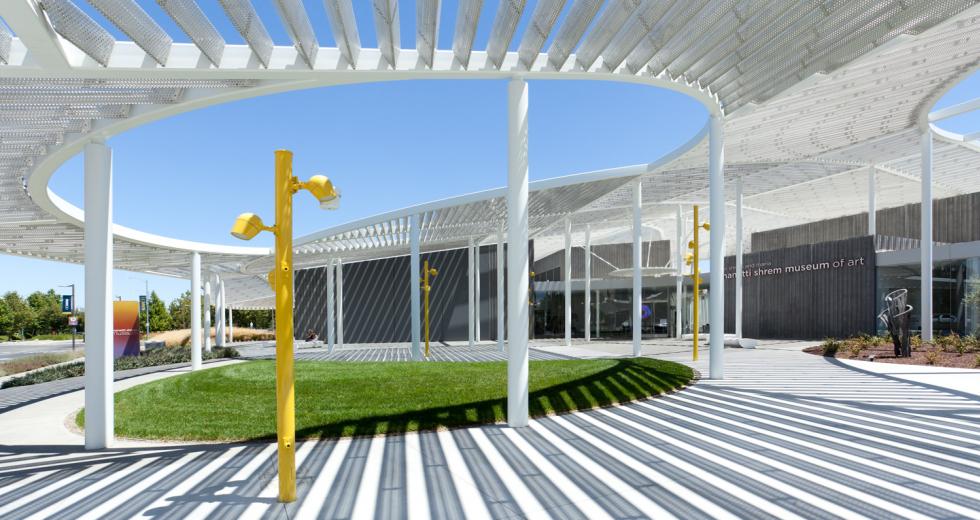Traditional museums and old-school performance centers — with silent hallways and auditoriums where photography is forbidden — are being rethought in favor of interactive educational spaces. The Capital Region boasts a number of vital, enriching educational institutions that intentionally link the arts and education communities to create welcoming spaces that are both inspiring and accessible. Many of these architecturally significant museums and performing arts centers are housed on our local high school and college campuses, where the next generation of artists are groomed.
Jan Shrem and Maria Manetti Shrem Museum of Art
UC Davis
Visitors view artwork on display at the Manetti Shrem Museum
(photo by Mike Graff)

“We like to say that everyone who steps in here becomes a student,” says Randy Roberts, deputy director of the Manetti Shrem Museum of Art at UC Davis. “We knew from the beginning that education would be at the core of the work that we’re doing.”
Born of first-generation artists that include the likes of legendary painter Wayne Thiebaud and famed ceramicist Robert Arneson — two of the most prolific and talented arts faculty in the country during the 1960s — the Manetti Shrem has its roots in the university’s long legacy of art-making. It is the first university museum in the U.S. to house a working art studio visible to all patrons of the museum. The $30 million, 30,000-square-foot site was completed in November 2016.
The building is designed with education spaces out front, with a third of the floor space devoted to instruction. “A lot of times with art museums, the real estate is so expensive that the education spaces will literally be in the basement or in the back of the museum,” Roberts says. “We have three education spaces that are in the education pavilion right up front as you enter the building.”
The interior lobby at the Manetti Shrem Museum looks out onto an
outdoor plaza (photo by Mike Graff)
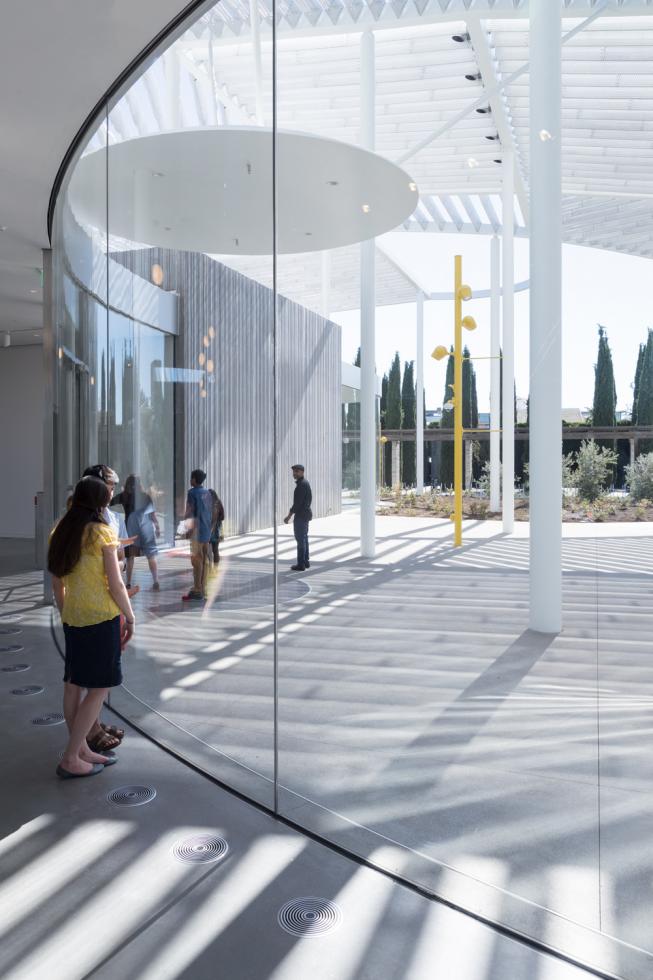
The pavilion includes a community education room, the Carol and Gerry Parker Art Studio and the Paul Lebaron Thiebaud Collections Classroom. The community education room was designed with reconfigurability in mind and can be used as a classroom, for large lectures or as a reception space with a versatile glass garage-style door that recedes into the ceiling. University classes of all stripes meet in the space. The working art studio has programming every weekend with a free drop-in studio for visitors and the community. The collections classroom is meant for close viewing, and even handling, of some of the university’s teaching collections. “It’s an experience that straddles what you do in a museum and what you do in a classroom,” Roberts says.
Designed in collaboration with contractor Whiting-Turner, New York-based architects SO-IL and San Francisco-based architects Bohlin Cywinski Jackson proposed an unconventional, one-story solution to meet the accessibility and openness mandate for the new museum. The ambitious design called for a dramatic canopy that extends well beyond the footprint of the building and includes 50,000 square feet of perforated aluminum triangular beams supported by 40 steel columns. “The idea of this grand canopy and this outdoor space as an introduction to an arts environment not only provides shade coverage, but was also meant to be an armature for exhibiting art,” says BCJ Principal Karl Backus.
The Manetti Shrem Museum’s inaugural exhibit “Out Our Way”
featured 240 pieces exploring the development of the UC Davis
Department of Art, founded in 1958. (photo by Mike Graff)

Apart from the infrastructure, light is also an important element of the design. “We did not want to just offer shade in the fastest way, but really wanted to use the light to activate the place underneath,” explains Florian Idenburg, founding partner of SO-IL. Alternating the orientation and spacing of triangulated, perforated beams gives every infill space a different type of light and shadow. The undulating canopy also takes its cues from the surrounding farmland.
Related: Randy Roberts on the Evolution of Museums
…
Harris Center for the Arts
Folsom Lake College
The Harris Center opened to a packed house for the national tour
of “A Chorus Line” in 2011. (photo by Mike Graff)

Located on the campus of Folsom Lake College, the Harris Center for the Arts functions as a world-class teaching laboratory for students and faculty, while also serving as a regional performing arts center for the public. Opened in February 2011, the $50 million, 80,000-square-foot facility was named for longtime Los Rios Community College District chancellor and arts patron, Brice Harris, and has three different performance venues called the Three Stages. The stages vary in size from an intimate recital hall that seats 100, to an 850-seat theater with a full fly tower and orchestra pit to accommodate a variety of performances. On average, the Harris Center hosts 400 events each year and welcomes 150,000 visitors.
The Center houses instructional programs for the college’s visual arts, theater, dance and music programs with facilities for teaching, rehearsals and performances. The site includes classroom space, a visual arts gallery and room for 60 faculty. It also includes a scene shop for building sets and props, a theater lab where students learn how to use theatrical lighting, space for warm-up and rehearsal, and one of the largest recording studios in the region. “The entire facility is like a real-world learning laboratory,” says Executive Director David Pier.
The Harris Center draws artists from all over the world, but also partners with local organizations to use the facility. The site hosts the Folsom Lake Symphony, the Sacramento Ballet and El Dorado Music Theatre and other local arts organizations. To quantify the Center’s economic impact, Pier generated a ripple effect report using a program created by Americans for the Arts, which shows how each dollar spent on a ticket generates additional dollars put into the community through meals, hotel stays and services. Using the organization’s parameters and metrics, Pier estimates that the Harris Center’s ripple effect in the first five years has been approximately $45 million. “The report helps demonstrate in monetary terms how arts organizations and arts facilities impact the community for the better,” he says.
Architecture firm LPAS designed most of the buildings on the
Folsom Lake College campus, including the Harris Center. (photo
by Mike Graff)

The Harris Center was designed by architecture firm LPAS, which started with a master plan for the college’s facilities nearly 20 years ago, and since then, has designed every building on campus except one, giving them the opportunity to create a unifying theme for both the design and the materials. The Harris Center sits at the top of a hill with a panoramic view of Folsom. “The building was designed to be a destination for the community,” says LPAS Vice President and Principal Curtis Owyang, “and had to express an open and welcoming attitude to draw people into the facility and the campus.”
…
Benvenuti Performing Arts Center
Natomas Charter School Performing and Fine Arts Academy
When Charlie Leo co-founded Natomas Charter School 25 years ago, he launched the Performing and Fine Arts Academy on campus, which was designed to enhance the learning experience for student artists. The academy was opened with the intent to also build a professionally-designed theater, but there was a shortage of funds. Leo opted to make room for the future building anyway and left a parking-lot-sized space in the middle of campus. In 2002, the Natomas Arts and Education Foundation was formed to support the school and help raise the necessary funds.
The Benvenuti Performing Arts Center, known as “The Ben,” is
located next to Natomas Charter School’s Performing and Fine Arts
Academy. The 364-seat theater includes advanced lighting, a wired
and wireless microphone system, a permanent sprung floor for
dance, and rigging for a full fly system. (photo by Mike Graff)

Leo was a founding member and board president of the NAEF and, along with other committee members, spent four years planning and generating revenue for the theater. “We wanted a full-fledged theater with a fly system and large seating capacity for the full professional experience by our students,” Leo says. “We did not want a high school auditorium.” The planning committee interviewed several architects for the project, but ultimately selected Williams+Paddon. The Roseville firm had a background in designing theaters and was well-grounded in school architecture. Groundbreaking for the 364-seat theater took place in November 2005, and the facility was completed in June 2007.
The new theater, named the Benvenuti Performing Arts Center after the late Sacramento developer Joe Benvenuti and his wife, Nancy, is utilized for a number of different kinds of academy student performances, both for the public and for on-site productions. The students’ marquee performances are geared toward the public and include large mainstage musicals, dance company performances, music ensemble performances, orchestras and jazz bands.
Events at Ben Arts range from student productions to professional
performances, symphonies, and concerts — at right, Natomas
Charter School’s production of “Grease” played at the center for
nine days in the fall of 2013. (photo by Mike Graff)

To offer students a professional performing arts experience, the Performing and Fine Arts Academy provides as many master’s classes as possible, which can range from bringing in professional musicians and dancers, to working with aspiring artists and filmmakers. For example, the academy and NAEF made contact with Heather Hach-Hearne, who wrote the narrative structure for “Legally Blonde: The Musical.” The students were putting on the musical performance and Hach-Hearne held a class to talk about the nuances of professional writing and acting. That night, Hach-Hearne stayed to watch the students perform and provide feedback. “Having a professional environment where that kind of interacting can take place really raises the level of experience, for both the students as well as the visiting artist,” says Matthew DeMeritt, program coordinator of the Natomas Charter School Performing and Fine Arts Academy.
Related: New & Improved B Street Theatre
Another recent master’s class from professional sculptor Elisabeth Higgins O’Connor taught students how to create large animalistic sculptures out of strips of cardboard, and then invited community members to see the art during a Second Saturday event. “What makes ‘the Ben’ so unique is the level of professionalism that is inspired by the state-of-the-art environment,” says NAEF Director Sierra Hersek. “Many schools are working out of multipurpose rooms that are a cafeteria by day and a performance space by night. The students that get to perform at ‘the Ben’ have an opportunity to work in a very professional environment.”
…
Conservatory of Music
University of the Pacific
With over 125 performances, activities and lectures, the Conservatory of Music on the campus of the University of the Pacific is the single largest arts presenter in San Joaquin County. The Conservatory functions in five different buildings, but the Spanos Concert Hall is the most iconic and widely-recognized space. Built in the 1920s, the three-story, 872-seat performance venue serves as the primary rehearsal space for Pacific’s orchestra and fully-staged spring opera, and is one of the original buildings on the Stockton campus. The facility is getting a much-needed facelift by the architecture firm LPAS, who will be renovating the bottom floor to include new storage facilities for the students’ musical instruments. The firm is also improving the university’s music practice rooms, music study rooms and musical instruction rooms. “What we are doing is not a large project, but it’s a very important project,” says LPAS Vice President and Principal Curtis Owyang.
The 872-seat Faye Spanos Concert Hall, housed inside the
University of Pacific’s Conservatory of Music, regularly hosts
the Conservatory’s Concert Series, Friends of Chamber Music
concerts, Stockton Opera and more. (photo by Mike Graff)

Pacific offers nine music degree programs to 200 students in a variety of disciplines. “When you look at the size of our Conservatory and the number of our students, coupled with the breadth of degree plans we offer, it is unmatched,” says Assistant Dean Jonathan Latta.
The Conservatory also offers a robust, professional advising program that covers counseling on everything from grad programs, summer internships, contacts in the professional music business, and launching a private studio or music therapy career. Pacific’s professional advising is an active part of the program and according to Latta, one that is often missing at larger institutions due to a lack of time, space and bandwidth.
In 1878, the Conservatory of Music became the first conservatory
west of the Mississippi. This building was built in 1927 and
holds not only the Spanos Concert Hall, but also faculty offices,
practice rooms and administration offices. (photo by Mike Graff)
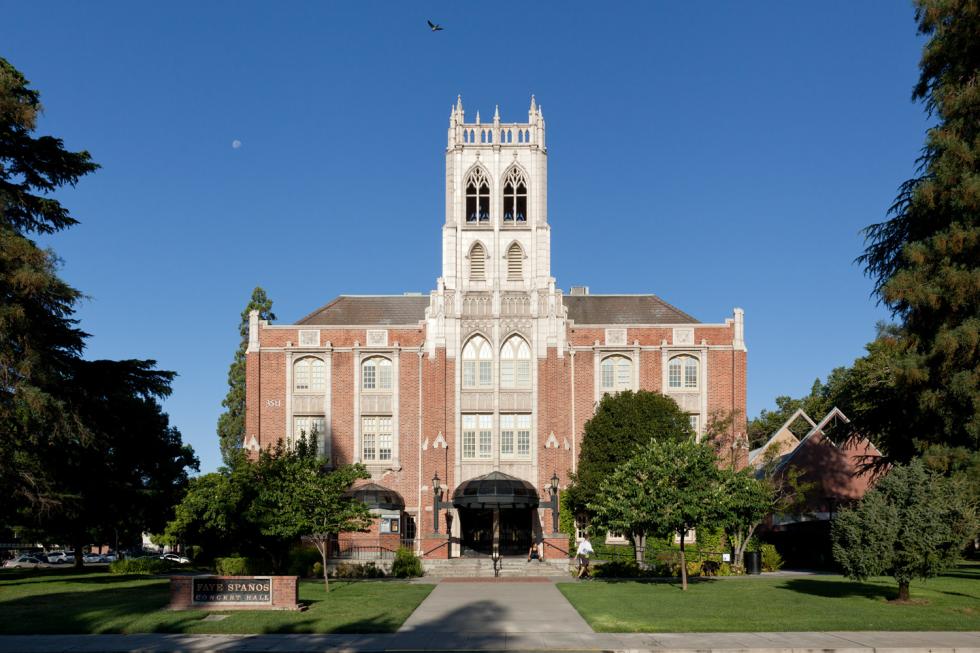
In their junior year, Pacific’s music education students serve as music teachers for four months with Stockton Unified School District, which lacks a designated music program. Internships and field work are also required of most of the programs. To connect to the community, the Conservatory frequently hosts music festivals on campus with up to 600 students for a full day of learning, and is home to the Central Valley Youth Symphony. A number of faculty also play in the Stockton Symphony, and Pacific provides a significant number of artistic and musical activities that bring an audience onto campus, including professional faculty recitals, faculty ensembles, gala orchestra recitals, opera performances, jazz performances and others.
Another unique program on campus is the Brubeck Institute’s Fellowship Program, named after renowned jazz musician and Pacific alum, Dave Brubeck. Each year, five students at the top of their instruments in jazz are selected from across the U.S. to receive a one-year scholarship to study jazz performance at the Institute. The students take a Brubeck seminar class each day and are mentored by guest artists, using the time to practice and develop as a band.
“The students come in as five individuals from around the country and we put them in a group and expect them to discover their voice,” says Interim Director Patrick Langham. Fellows perform both locally and abroad in universities, high schools, clubs, concert series and jazz festivals. Students and faculty from Pacific, as well as visiting artists, also perform weekly for the community as the Take 5 Jazz Club at Valley Brewing Company in Stockton.
Recommended For You
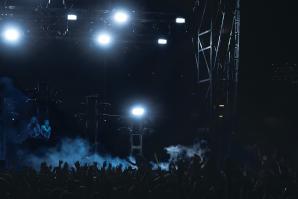
The Little Music Festival That Was
What happened to TBD Fest — and what happens next?
After losing an undisclosed sum both years, TBD Fest (otherwise known as The Bridge District Festival) has incurred blame from investors and rival music promoters for being underfunded. General consensus is that if a festival can’t pay for its talent before selling a single ticket, it’s under-capitalized.
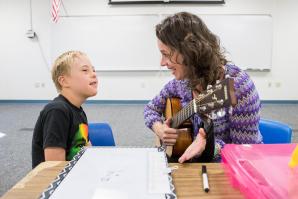
Striking a Chord
Music isn’t just good for the soul — it’s good for the heart, mind and body
Founded in 2000, Music to Grow On focuses on special-needs children and works in 20 school districts throughout the greater Sacramento region. Barth describes music therapy as “the use of music to reach non-musical goals,” which can include everything from communication and motor skills to memory and academics.



